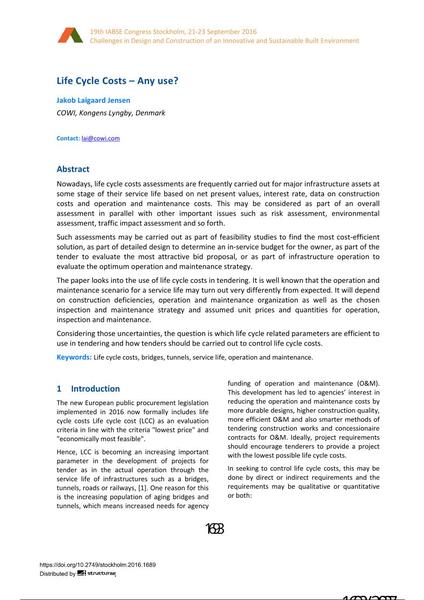Life Cycle Costs – Any use?

|
|
|||||||||||
Bibliografische Angaben
| Autor(en): |
Jakob Laigaard
(COWI, Kongens Lyngby, Denmark)
|
||||
|---|---|---|---|---|---|
| Medium: | Tagungsbeitrag | ||||
| Sprache(n): | Englisch | ||||
| Tagung: | IABSE Congress: Challenges in Design and Construction of an Innovative and Sustainable Built Environment, Stockholm, Sweden, 21-23 September 2016 | ||||
| Veröffentlicht in: | IABSE Congress Stockholm, 2016 | ||||
|
|||||
| Seite(n): | 1693-1700 | ||||
| Anzahl der Seiten (im PDF): | 8 | ||||
| Jahr: | 2016 | ||||
| DOI: | 10.2749/stockholm.2016.1689 | ||||
| Abstrakt: |
Nowadays, life cycle costs assessments are frequently carried out for major infrastructure assets at some stage of their service life based on net present values, interest rate, data on construction costs and operation and maintenance costs. This may be considered as part of an overall assessment in parallel with other important issues such as risk assessment, environmental assessment, traffic impact assessment and so forth. Such assessments may be carried out as part of feasibility studies to find the most cost-efficient solution, as part of detailed design to determine an in-service budget for the owner, as part of the tender to evaluate the most attractive bid proposal, or as part of infrastructure operation to evaluate the optimum operation and maintenance strategy. The paper looks into the use of life cycle costs in tendering. It is well known that the operation and maintenance scenario for a service life may turn out very differently from expected. It will depend on construction deficiencies, operation and maintenance organization as well as the chosen inspection and maintenance strategy and assumed unit prices and quantities for operation, inspection and maintenance. Considering those uncertainties, the question is which life cycle related parameters are efficient to use in tendering and how tenders should be carried out to control life cycle costs. |
||||
| Stichwörter: |
Brücken Lebensdauer Lebenszykluskosten Tunnel
|
||||
